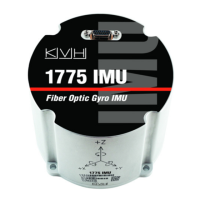This document contains proprietary information of KVH Industries, Inc. and neither this document nor said proprietary information shall be
published, reproduced, copied, disclosed, or used for any purpose without the express written permission of a duly authorized KVH
representative.
The default output filtering can be restored using the =FC20 command’s reset parameter or by
using the CHEBY keyword type without any additional parameters.
Changing the Master Synchronization Input to external (=MSYNC,EXT) will automatically
change the filter type to the Uniform Averager type. This filter type will remain even after
changing the Master Synchronization Input back to =MSYNC,IMU type later on. When using
the external MSYNC mode, if the user wants a different filter than the Averager type they must
configure it with the =FILTTYPE command after issuing the =MSYNC,EXT command.
8.16.2 Usage
=FILTTYPE,<A|G>,<CHEBY|BUTTER|AVE><,additional parameters>
Uniform Averager USAGE: =FILTTYPE,<A|G>,AVE
There are no optional or additional parameters for the Averager. As with other final output
filters, use of the data rate (=DR) command may affect the averaging filter input rate by
changing the internal sampling rates. When using the Averager filter and external output
request, KVH recommends setting the data rate configuration to 1000 Hz, even if the user
does not expect to drive the output request at that rate, to use the fastest internal averaging.
For IMU-generated data output timing, the averaging period will automatically adjust with the
chosen data rate.
Butterworth USAGE: =FILTTYPE,<A|G>,BUTTER<,N,FCUTOFF>
The N and FCUTOFF parameters are optional and, if not used, then the default is 8
th
order and
the cutoff frequency is at 1/2 of the configured data rate. If optional parameters are used, then
both parameters must be specified and the desired data rate should be configured prior.
Optional parameters:
N is filter order; integer with range 1 to 8
FCUTOFF is filter cutoff frequency in Hz; floating-point value, range is 0 to 2500 Hz.
KVH recommends setting this to less than 1/2 the expected data output rate, although
values up to 1/2 the internal sampling rate are accepted. That is, the 2500 Hz or lower
value would be used with at the maximum 5000 Hz data rate.

